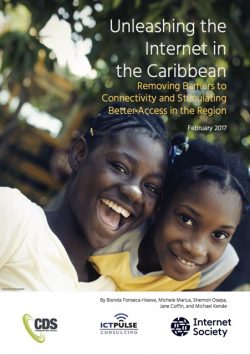Please follow the link above to download the complete report. You may also:
- Read the announcement news release.
- View the video of the launch event in Barbados on 17 Feb 2017.
Updates:
- 21 Feb 2017 – New version uploaded with minor corrections.
Executive Summary
The nations of the Caribbean region are scattered over an area of more than 2.75 million square kilometres. These small, developing countries are mostly isolated from each other by the Caribbean Sea and Atlantic Ocean. As such, they have greater Internet connectivity challenges than do mainland developing nations, which further limits the extent to which they can participate in the developing information society.
Commissioned by the Internet Society, this study identifies solutions that promote continued development of the Internet in the Caribbean, specifically with respect to infrastructure and access services, and provides recommendations to help address the region’s unique challenges. The study focuses on the following 11 countries and territories, which were selected to sample the diversity of the region’s 30 different sovereign countries and 17 island territories administered by France, the Netherlands, the United States and the United Kingdom: the Bahamas, Barbados, British Virgin Islands, Curaçao, Dominica, Grenada, Haiti, Jamaica, Sint Maarten, Suriname, and Trinidad and Tobago.
With regard to Internet infrastructure, most of the countries in this study have at least two independent submarine cable systems providing connectivity both regionally and to global Internet networks. Internet services are delivered in-country via a combination of fibre-optic, coaxial and copper cables, and fixed or mobile wireless networks. Second-generation (2G) mobile/cellular networks cover most of the population, providing basic telecommunications (voice and text messaging) services. Increasingly, newer third-generation (3G), fourth-generation (4G) and long-term evolution (LTE) mobile technologies that support mobile broadband Internet are being deployed.
Largely reflecting the varying levels of economic development in the region, Internet use varies considerably—from as low as 11% of the population in Haiti to almost 80% in Barbados and the Bahamas (2014). The density of fixed broadband subscribers is generally low—from less than 4 subscriptions per 100 inhabitants in the Bahamas to almost 27 subscriptions per 100 inhabitants in Barbados (2014). The rapid adoption and use of mobile/cellular phones in the region, however, fuelled by aggressive promotion of broadband services by mobile operators and the increasing deployment of free/public Wi-Fi networks, are likely to substantially increase the short- to medium-term Internet adoption and use.
With some exceptions, such as Haiti and the Bahamas, the coverage of Internet infrastructure is relatively good, but there is still room for improvement. There are a number of challenges, however, that constrain most countries in the region from becoming digital societies.
- Caribbean governments have been largely responsive rather than proactive in nurturing the development of the Internet to meet their countries’ needs. As a result, the policy environment required to enable the development and use of Internet infrastructure—particularly legal frameworks that promote affordable services via properly managed competition—are underdeveloped in most countries and still oriented toward the promotion of basic voice communications.
- Government support structures, such as investment incentives to improve coverage, are limited. The development of relevant content, services and applications (particularly e-government) would drive demand.
- Even if Internet access costs were to drop significantly, low-income populations might still find Internet services and access equipment unaffordable or of limited value relative to their income levels.
- Although some countries report relatively high numbers of Internet subscribers among their populations, these numbers do not necessarily correspond to proficient or extensive use of the medium to harness its development potential.
We recommend the following to address these challenges:
- Develop clear and forward-looking policy and regulatory frameworks that focus on developing the Internet and information and communications technology (ICT) both in individual countries and across the region as a whole.
- Encourage greater private-sector participation and innovation by improving the enabling environment and the support ecosystem in general, paying particular attention to fostering increased competition in the Internet access market and promoting open access to shared facilities, such as telecentres and innovation hubs (iHubs).
- Implement initiatives that foster greater participation by the public, including initiatives that improve digital literacy and increase the availability of free access to public institutions.
- Ensure that the ICT projects implemented are properly aligned with the country’s needs and development priorities.
- Adopt a regional approach and system of collaboration on common problems and goals, taking advantage of the benefits that emerge—especially with regard to implementation costs—due to the economies scale and scope that can be realised.
